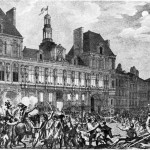
Paris was discovered by a Gauls from the Parisii tribe in 250 BC who first found the fishing village on an island in the river. At present, it is referred as Ile de la Cité. Paris’ lands were wealthy; it made a perfect strategic location for trade and business operations. But the area was under Roman control after the revolt in 52 BC led by Julius Caesar. The Romans crushed the rebels at the area and then took control of the entire city. At the end of the same century, Paris’s Ile de la Cité became the centre of a new Roman settlement called Lutetia.
Under the Roman rule, the town was greatly influenced with the Roman culture and grew significantly. Lutetia was named Paris in 212, after the local tribe, but the rest of 3th and 4th century was wracked by war. Sadly, the city was came under attack from barbarian aggressors putting Roman rule to collapse effectively in the 5th century.
According to fable, was saved from the hands of Attila the Hun through the prayers for relief led by the piety of Sainte Geneviève. Their prayers were answered when Attila’s march turned away from Paris to the south. Sainte Geneviève remains Paris’s patron saint to this day.
The city’s escape from Attila was just a short-term relief for the city. It was then attacked in 464 by Childeric, where his con made the city its capital. Childeric was buried there in 511 on that same city. By this time, Paris was a typically crowded early medieval city with timber buildings alongside surviving Roman remains. According to the chronicler Gregory of Tours, it suffered a disastrous fire in 585. The city grew beyond the boundaries of the Ile de la Cité, with suburbs being established on both banks of the river.
The French revolution started in Paris, where the King ordered his foreign troops to subdue any unrest. Paris became the panorama of revolution, with political groups taking over establishments for their headquarters. The royal family were reduced to virtual prisoners in the Tuileries. They tried to escape on June 20 of 1791 but they were unsuccessful and returned to Paris as captives. In 1800, Napoleon was declared the new consul and on the same year, he returned to Russia to kill his own people.
In the 19th century, under Napoleon’s rule, Paris became the centre of an empire and enormous military power. He crowned himself as the Emperor in Notre-Dame on May 18 1804. He saw Paris as “new Rome” and set about building public monuments befitting the capital of an empire. It is also during Napoleon’s rule where Paris developed to its modern form. He appointed a Prefect named Baron Haussmann and was in charge of modernising the city. Haussmann did a great job, although demolishing some of the old Paris structures, but then replaced it with a network of wide, straight boulevards and radiating circuses. But even if Haussmann was forced to resign because of corruption, his term was of great responsibility of what Paris look like nowadays.

This is such a great resource that you are providing and you give it away for free. I enjoy seeing websites that understand the value of providing a prime resource for free. I truly loved reading your post. Thanks!
During my stay in Paris last year, I was able to pick up and learn a thing or two about Paris and its history. I admire how Paris has been able to rise up from everything they have been through. Now,it is one of the leading cities in the whole world. I live in a country which also went through a lot in the course of history, unfortunately our country has not been able to rise up from it all and become as successful as Paris at present. I guess this is why Paris remains to be one of my favorite cities in the world.
Paris really had problems in the past that makes you wonder how they overcame it all and turned out to be a perfect city. Paris was so chaotic in the past but they utilized it to build a better city. These can be seen through their infrastructures which has historical values that turns to be the most popular tourists spots. There are museums that collects historical items that are valuable to the history of the Parisians. There are learning and values that are still continued by the Parisians at present which are inspired by their past leaders and icons. I should say that the Parisians are perfect role models because of their determination, creativity and hard work.
This is such a great website, concise yet creative style of writing. Thank you for providing this great resource for free, I learned a lot 🙂
Your blog kinda sucks! You should change the way you write and probably the wordpress theme. Else is just a time losing method. I don’t want to be a bastard, is just a friendly advice